3 YEAR UPDATE
Baldwin Hills Test Plot
By Jen Toy
Test Plot Lead
TEMP: 62 F
︎WEATHER: Overcast, warm and gray
WIND (SPEED/DIRECTION): 5 mph from north
SOIL MOISTURE: Didn’t test
︎PLANTS SIGHTINGS: Everything is super dense and lush.
WEED SIGHTINGS: Some black mustard popping up here and there, and still on the perimeter
︎WILDLIFE SIGHTINGS: Hummingbirds
︎HUMAN ACTIVITY: Lots of folks walking on the road for their morning exercise. The plot remains closed via wire fencing.
GENERAL NOTES: The oak woodland and coast scrub species are thriving and quickly crowded out grassland species. There’s still a good amount of diversity. I observed 18 out of the original 37 species planted. Most of what didn’t make it are wildflower and grasses in the seed mix. Detailed notes below.
Baldwin Hills Test Plot
By Jen Toy
Test Plot Lead
DATE: June 08 2024
TIME: 7:30amTEMP: 62 F
︎WEATHER: Overcast, warm and gray
WIND (SPEED/DIRECTION): 5 mph from north
SOIL MOISTURE: Didn’t test
︎PLANTS SIGHTINGS: Everything is super dense and lush.
WEED SIGHTINGS: Some black mustard popping up here and there, and still on the perimeter
︎WILDLIFE SIGHTINGS: Hummingbirds
︎HUMAN ACTIVITY: Lots of folks walking on the road for their morning exercise. The plot remains closed via wire fencing.
GENERAL NOTES: The oak woodland and coast scrub species are thriving and quickly crowded out grassland species. There’s still a good amount of diversity. I observed 18 out of the original 37 species planted. Most of what didn’t make it are wildflower and grasses in the seed mix. Detailed notes below.
SUMMARY: After three seasons ofwinter rains, the Baldwin HIlls plot is looking lush and impenetrable. I think this plot is most similar to the “microforest” strategy as it’s one larger plot planted with a ton of biodiversity and densely packed. Background refresher: Back in November 2021 we planted 250 x 1 gallons and seeded with 1 lb. of a custom grassland seed mix created with Theodore Payne - all in an area of ~5,000sf. The original experiment was to test 3 different plant communities: oak woodland, coast scrub and grassland to see which would fare better given continued disturbance, the extremes of climate change, andthe evolving dynamics of our urban ecology. The first winter (2021-2022) was fairly dry (12.4”) and we watered the plot monthly for that first year or so. The second two winters (2022-23 and 2023-24) were unprecedented, dumping 28.4” and 25.2”, respectively. As noted in Arely’s 2023 post the perennials and shrubs were fairly established by early in the second winter.
While visiting the plot on June 8th, I took note of the species that I saw and was curious which ones would be dominant and/or thriving after 3 years. The plot is so dense that you can’t walk around it. There’s a narrow maintenance path through the middle and you can go partially around the perimeter to the left, but the right side is busting at the seams to the fence edge. I think it is time to remove the fencing and expand the area. Nature Nexus Institute has started to clear the adjoining hillside of black mustard and plant along the upslope.
Here’s what I saw by plant community:
OAK WOODLAND
- Juglans californica (CA walnut tree) - we planted 4 along the perimeter and I saw one that has taken off and now leafing out and 4-5 feet tall.
- Sambucus nigra ssp. caerulea (Blue elderberry). There was one existing that we planted around and has benefited from the plot. We planted 4 and I could see at least 2 from my cursory look.
These shrubs are all taking off:
- Lonicera subspicata (Southern honeysuckle)
- I also saw a white flowering species of honeysuckle (perhaps Lonicera albiflora) which wasn’t on our original plant list (mystery where it came from)
- Ribes aureum (Golden currant)
- Ribes speciosum (Fucsiaflower gooseberry) is completely spectacular and not a common plant in the area, but is so happy
- Keckiella cordifolia (Climbing penstemon)
- There was a bit of Rosa californica (CA wild rose) but it was low and I only saw a handful of flowers… perhaps it doesn’t have enough room to really become a thicket like it wants to.
- The Salvia spathacea (Hummingbird sage) is also doing ok, though as a low grower it needs to fight for sunlight. I mainly saw it along the edges of the central path.
- I did not see any oak or toyon, but they may have been hidden. We planted 4 each.
COASTAL SAGE SCRUB
This is the dominant habitat across Baldwin Hills that the NNI has been working to restore. And for good reason. There was an existing black and white sage that we planted around and those both have expanded and take up close to 10’ diameter each.
These gals are dominant:
- Artemesia californica (CA sagebrush)
- Encelia californica (Bush sunflower)
- Salvia apiana (White sage)
- Salvia mellifera (Black sage)
- Acmispon glaber (Deerweed)
- Peritoma arborea (Bladderpod)
I did not see these species:
- Eriogonum fasciulatum (CA buckwheat) which is interesting b/c it is thriving along with Bush sunflower and white sage all around nearby areas. Perhaps because those areas were seeded, the buckwheat was able to compete? At Rio, our “seed only” plot is now all buckwheat, so when it’s happy it takes off quickly.
- Epilobum canum (CA fuschia)
- Calystegia macrostegia ‘Anacapa pink’ (Island morning glory)
- Salvia columbariae (Chia)
GRASSLAND
In general, I think the plot is too dense and tall for these species to have taken off. We also mostly planted this community via seed. If I were to do this again, I would have planted the woodland and sage less densely, maybe 5’ o.c. and increased the density and quantity of grassland live plants. So the effect would be islands of taller shrubs/perennials surrounded by lower areas of grassland/wildflower species, at least in the first 3 years. After that I’d guess the woodier species would take over given regular rainfall, but it may have been a fairer start for the grassland species.
That said, the grassland species I observed are:
- Asclepias fascicularis (Narrowleaf milkweed) is pretty prevalent along the western edge and is spreading and creating babies at the edges of the plot.
- Solidago velutina ssp. californica (Goldenrod) is currrently in full yellow glorious bloom.
- The Helianthus californica (Sunfower) are rising up and peeking their sunny sunflowers out all over the plot, which is pretty cool since they were all seeded.
- There was a bit of Eriophyllum confertiflorum (Golden Yarrow).
I didn’t see any of these grassland species:
- Achillea millefolium (Common Yarrow)
- Bloomeria crocea (Goldenstar)
- Clarkia unguiculata (Elegant clarkia)
- Corethrogyne filiginfolia (CA aster)
- Deinandra fasciculata (Clustered tarweed)
- Dichelostemma capitatum (Blue dicks)
- Eschscholzia californica (CA poppy)
- Gilia capitata (Globe gilia)
- Lasthenia californica (Goldfields)
- Lupinus succulentus (Arroyo lupine)
- Nemophilia menziesii (Baby blue eyes)
- Stipa cernua (Nodding needlegrass)
- Stipa pulchra (Purple needlegrass)
WHAT’S IN BLOOM
Baldwin Hills Scenic Overlook Test Plot
The weather at the Overlook has mostly been sunny, with a combination of clouds and some rain peaks. Since we have had a decent amount of rain, we have not watered the test plot since January. We kept the test plot as a special site for volunteers to restore habitat and see a thriving native plant site. Our volunteers have mainly been weeding wild radish, mustard, and castor bean and fixing basins for our small native plants. Fortunately, many of the shrubs that were planted are fully established. We have had ground squirrels, rabbits, black phoebes, California towhees, song sparrows, western fence lizards, Harlequin bugs, honey bees, bumble bees, and sweat bees. A male anna’s hummingbird has claimed the Elderberry as his territory.
Baldwin Hills Scenic Overlook Test Plot
DATE: March 07 2023
The weather at the Overlook has mostly been sunny, with a combination of clouds and some rain peaks. Since we have had a decent amount of rain, we have not watered the test plot since January. We kept the test plot as a special site for volunteers to restore habitat and see a thriving native plant site. Our volunteers have mainly been weeding wild radish, mustard, and castor bean and fixing basins for our small native plants. Fortunately, many of the shrubs that were planted are fully established. We have had ground squirrels, rabbits, black phoebes, California towhees, song sparrows, western fence lizards, Harlequin bugs, honey bees, bumble bees, and sweat bees. A male anna’s hummingbird has claimed the Elderberry as his territory.






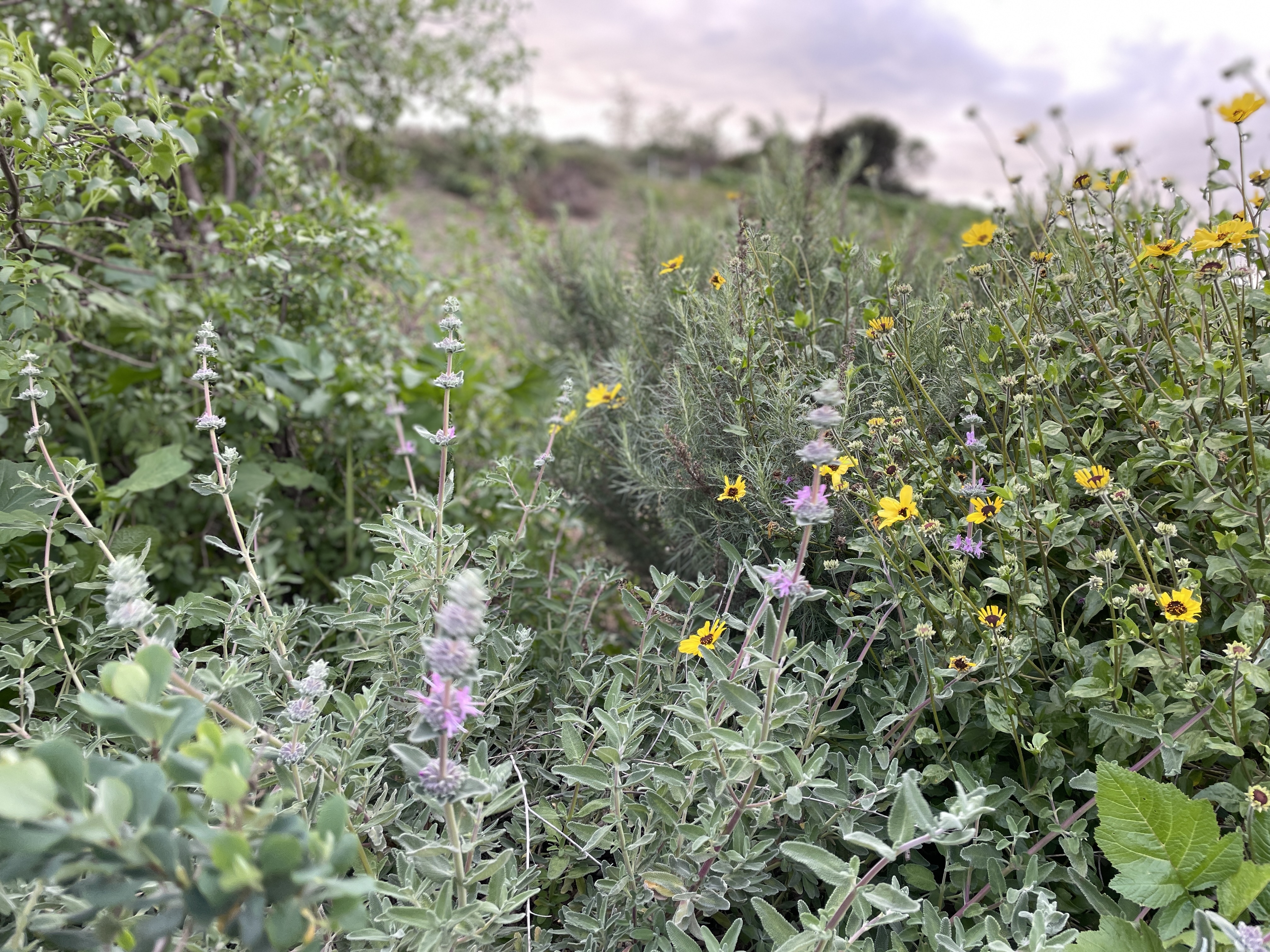
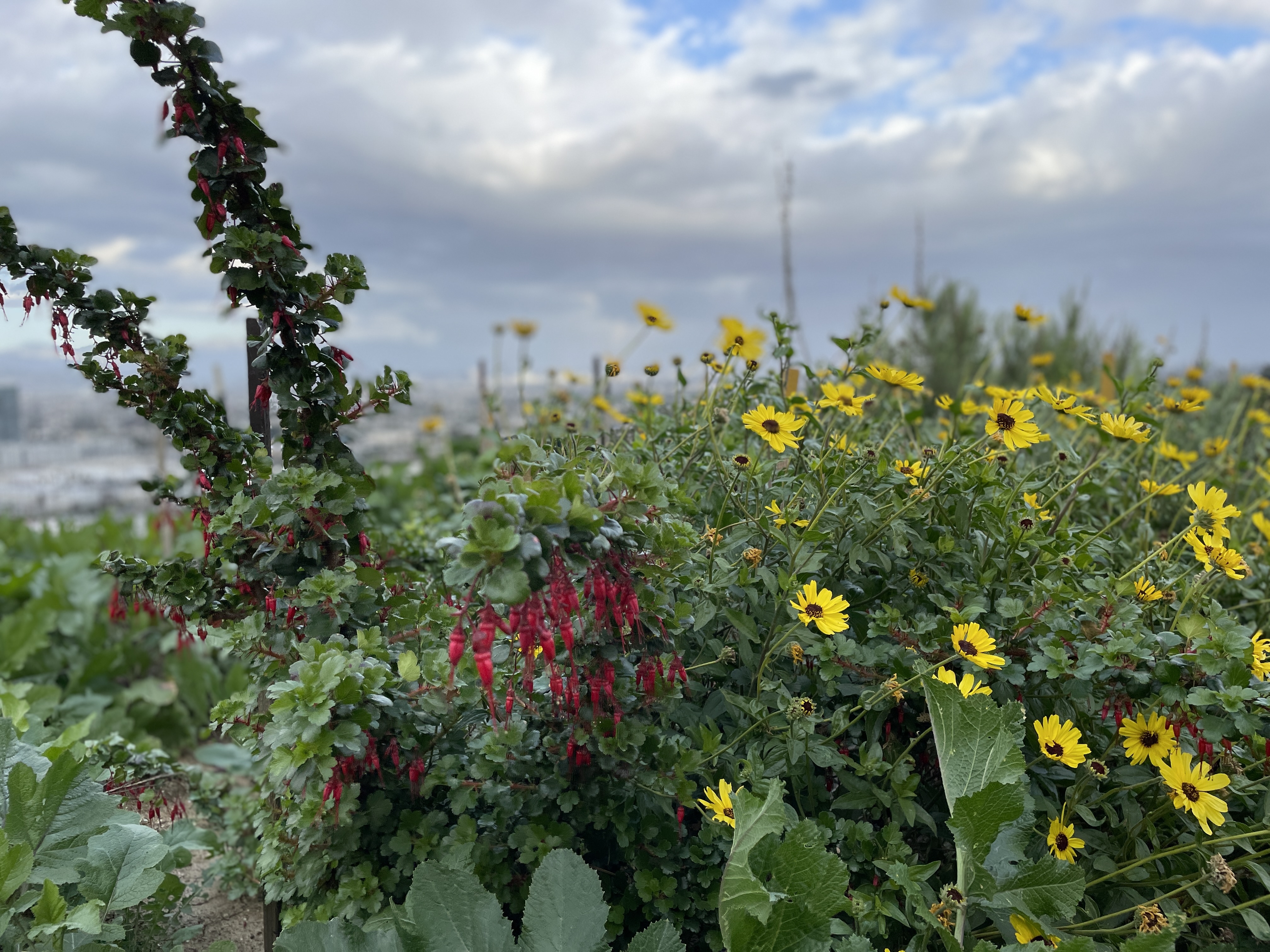
Current Plant List
Artemisia californica-- California sagebrush
Artemisia suksdorfii-- Coastal mugwort
Asclepias fascicularis-- Narrow-leaf milkweed
Encelia californica-- California brittlebush (blooming)
Epilobium canum-- California fuchsia
Eriophyllum confertiflorum-- Golden yarrow (from seed)
Helianthus annuus-- Common sunflower (blooming) (from seed)
Heteromeles arbutifolia-- Toyon
Juglans californica-- California black walnut
Keckiella cordifolia-- Heartleaf keckiella (blooming)
Lonicera subspicata-- Southern honeysuckle (blooming)
Lupinus succulentus-- Arroyo lupine (blooming) (from seed)
Muhlenbergia rigens-- Deer grass
Peritoma arborea-- Bladderpod (blooming)
Quercus agrifolia-- Coast Live Oak
Ribes speciosum-- Fuchsia flower gooseberry (blooming)
Rosa californica-- California wildrose
Salvia apiana-- White sage
Salvia leucophylla-- Purple sage (blooming)
Salvia mellifera-- Black sage (blooming)
Salvia spathacea-- Hummingbird sage (blooming)
Sambucus mexicana-- Mexican elderberry
Solidago californica-- California goldenrod
THE PLOT WITH THE VIEWS
Starting Baldwin Hills
By Daniela Velazco
Test Plot Intern
DATE: November 2021
The Baldwin Hills Test Plot came together through a collaboration between the Nature Nexus Institute, USC Landscape Architecture graduate students, and local high school students and volunteers.
![]()
![]()
![]() The folks at Nature Nexus Institute have worked hard to take the hills from largely overrun by non-native invasive species to hills of coastal sage scrub habitat patchworked throughout the park. With their help, we turned a 5,000 square foot area near the top of the hill by the Skyline Terrace Amphitheater from a field of mustard into a testing site for speculative climate futures.
The folks at Nature Nexus Institute have worked hard to take the hills from largely overrun by non-native invasive species to hills of coastal sage scrub habitat patchworked throughout the park. With their help, we turned a 5,000 square foot area near the top of the hill by the Skyline Terrace Amphitheater from a field of mustard into a testing site for speculative climate futures.
Below is a breakdown of what was done.
1. Prep the site.
The staff at the Nature Nexus Institute hand pulled wild mustard in early August. They left a few bladderpod plants, black sages, a tobacco tree (home to a resident hummingbird) and a large white sage.
![]()
![]()
![]() 2. MLA graduate students visited the site to prepare for research on the site’s current ecology/ historic ecology and site uses.
2. MLA graduate students visited the site to prepare for research on the site’s current ecology/ historic ecology and site uses.
![]()
![]()
![]()
![]()
![]() 3. In late August we started a grow/kill cycle to stimulate the many years of seeds below ground in the seedbanks. We watered the site weekly and once the plants (mostly black mustard) began to sprout we’d weed and water again.
3. In late August we started a grow/kill cycle to stimulate the many years of seeds below ground in the seedbanks. We watered the site weekly and once the plants (mostly black mustard) began to sprout we’d weed and water again.
![]()
![]()
![]()
![]()
*A note on black mustard: black mustard is an extremely resilient non-native brought to California from Europe. The plant with the huge green leaves with yellow flowers that covers the Los Angeles hillsides in the Spring. It does extremely well in nitrogen areas thriving off the nitrogen from our car exhaust pipes. It grows faster than our native species, choking them out before they’ve had a chance to grow. By removing it and planting natives, we are creating more much needed habitat that local species need to survive. It was also a huge fire hazard!
4. The Test
Climate experts predict a future of more extreme weather events. As we’ve seen this year, this can mean heavier rainfall, storms, and/or longer drought. As a studio class we developed a test based on these predictions using the selected species and planting strategy as variables for the site.![]() We landed on a strategy that takes 3 different California native plant communities and intermixed them on site.
We landed on a strategy that takes 3 different California native plant communities and intermixed them on site.
-Oak woodland based on the historic ecology of the north facing slope
-Coastal sagescrub based on the sites current ecosystem
-Grassland, a plant community that thrives in disturbance
The intent is that the diverse initial planting palette will allow the land to sort out into the appropriate future community makeup.![]()
![]()
![]()
Starting Baldwin Hills
By Daniela Velazco
Test Plot Intern
DATE: November 2021
The Baldwin Hills Test Plot came together through a collaboration between the Nature Nexus Institute, USC Landscape Architecture graduate students, and local high school students and volunteers.


 The folks at Nature Nexus Institute have worked hard to take the hills from largely overrun by non-native invasive species to hills of coastal sage scrub habitat patchworked throughout the park. With their help, we turned a 5,000 square foot area near the top of the hill by the Skyline Terrace Amphitheater from a field of mustard into a testing site for speculative climate futures.
The folks at Nature Nexus Institute have worked hard to take the hills from largely overrun by non-native invasive species to hills of coastal sage scrub habitat patchworked throughout the park. With their help, we turned a 5,000 square foot area near the top of the hill by the Skyline Terrace Amphitheater from a field of mustard into a testing site for speculative climate futures.Below is a breakdown of what was done.
1. Prep the site.
The staff at the Nature Nexus Institute hand pulled wild mustard in early August. They left a few bladderpod plants, black sages, a tobacco tree (home to a resident hummingbird) and a large white sage.



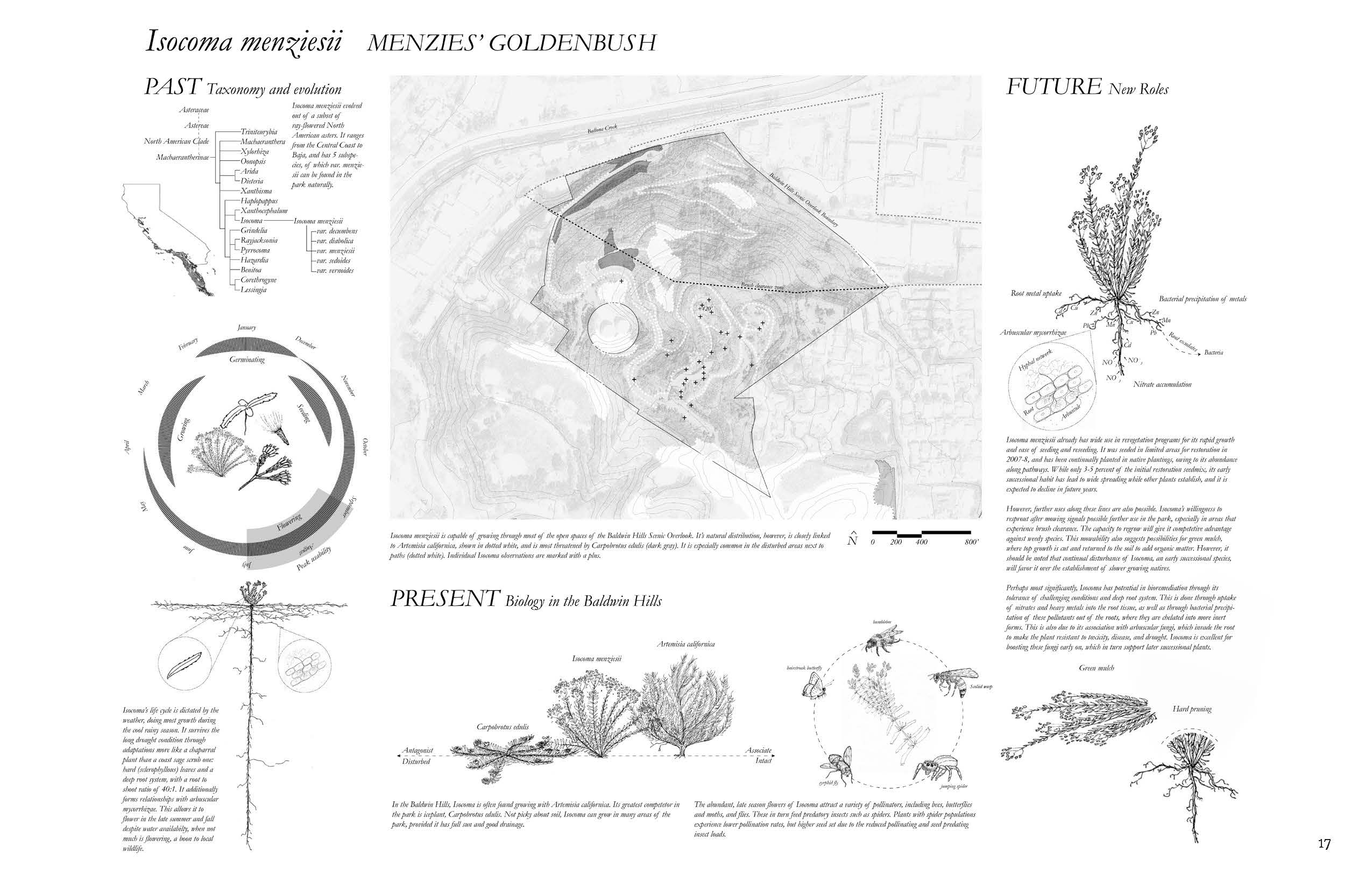
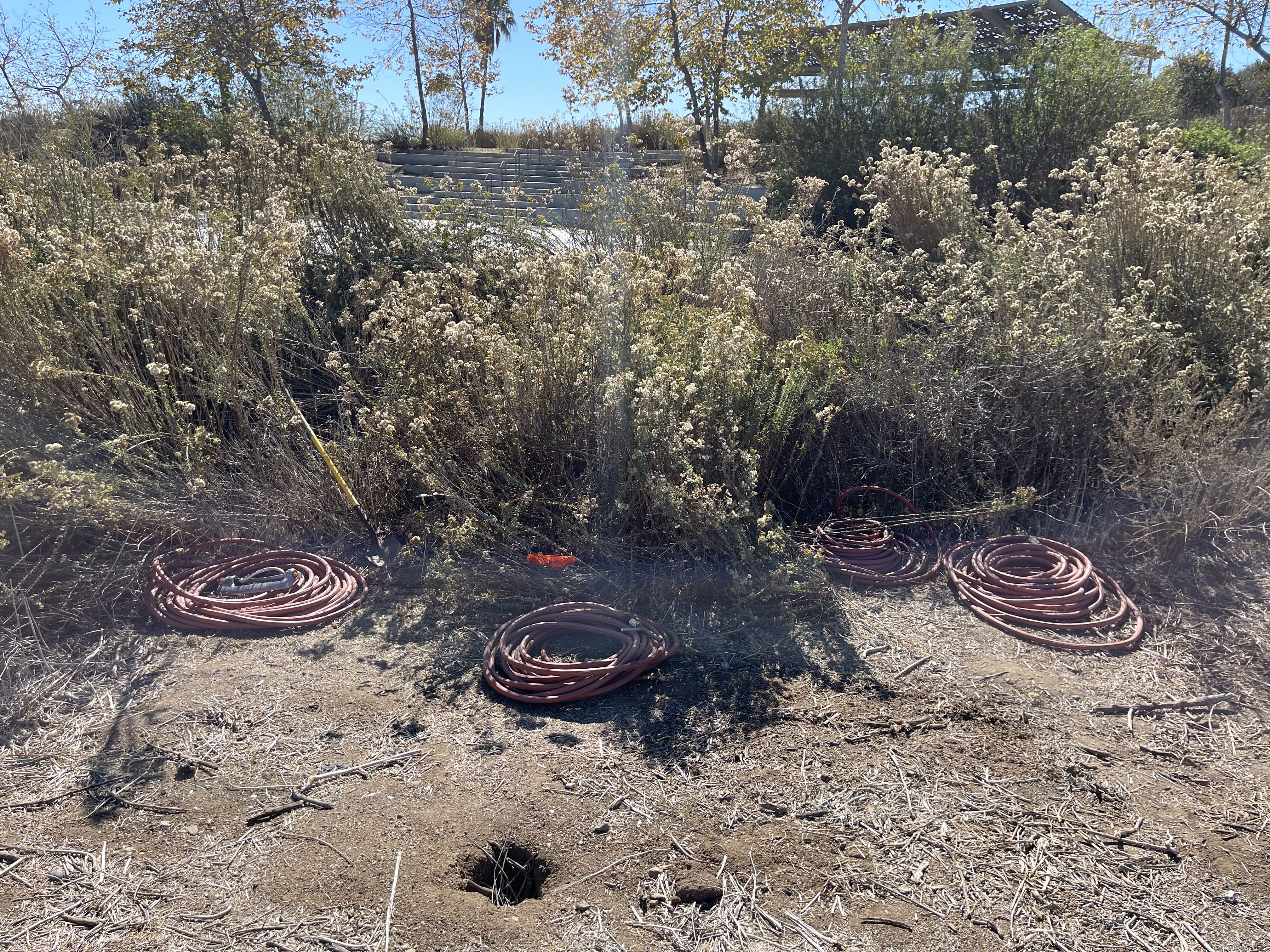
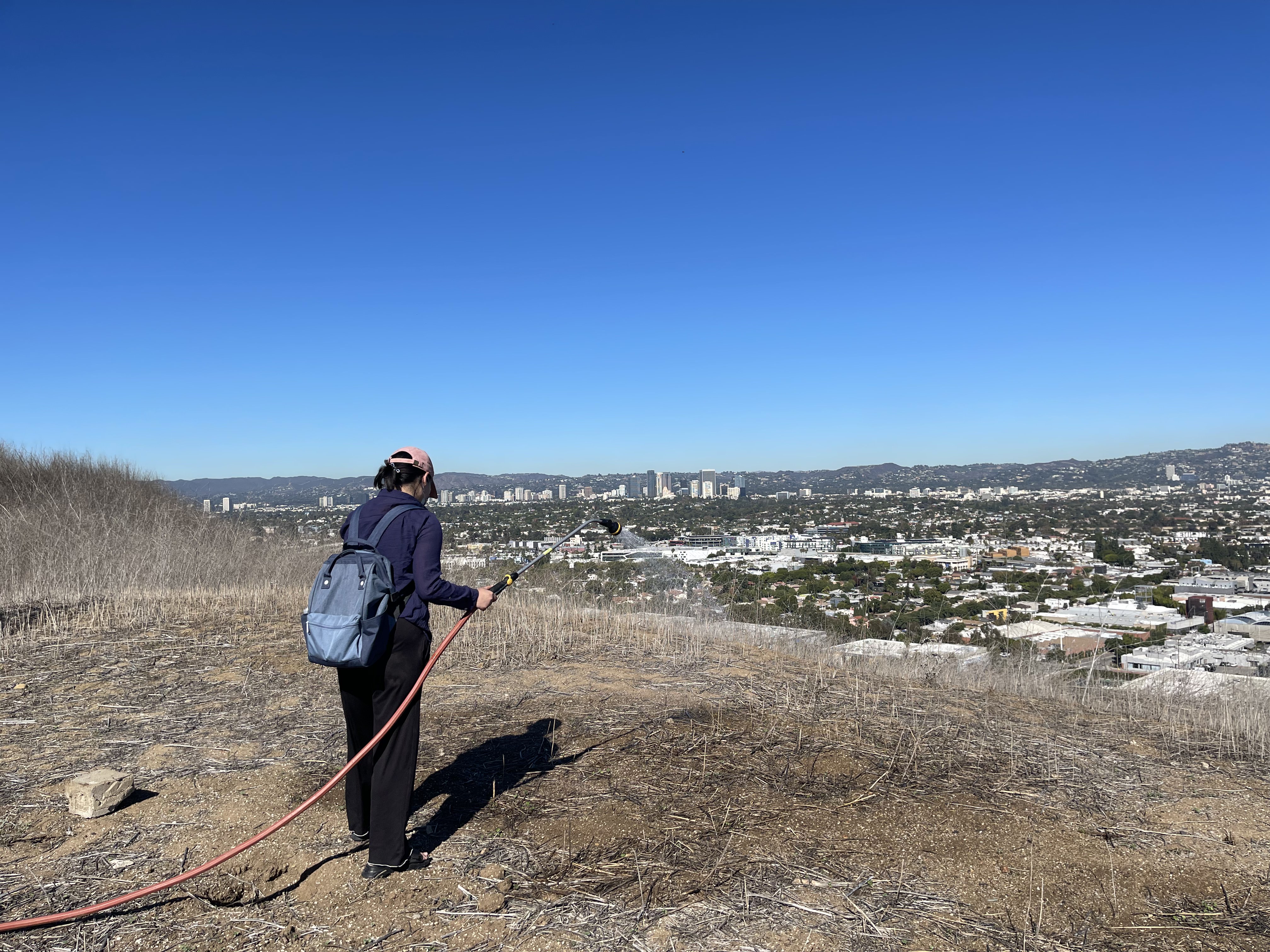
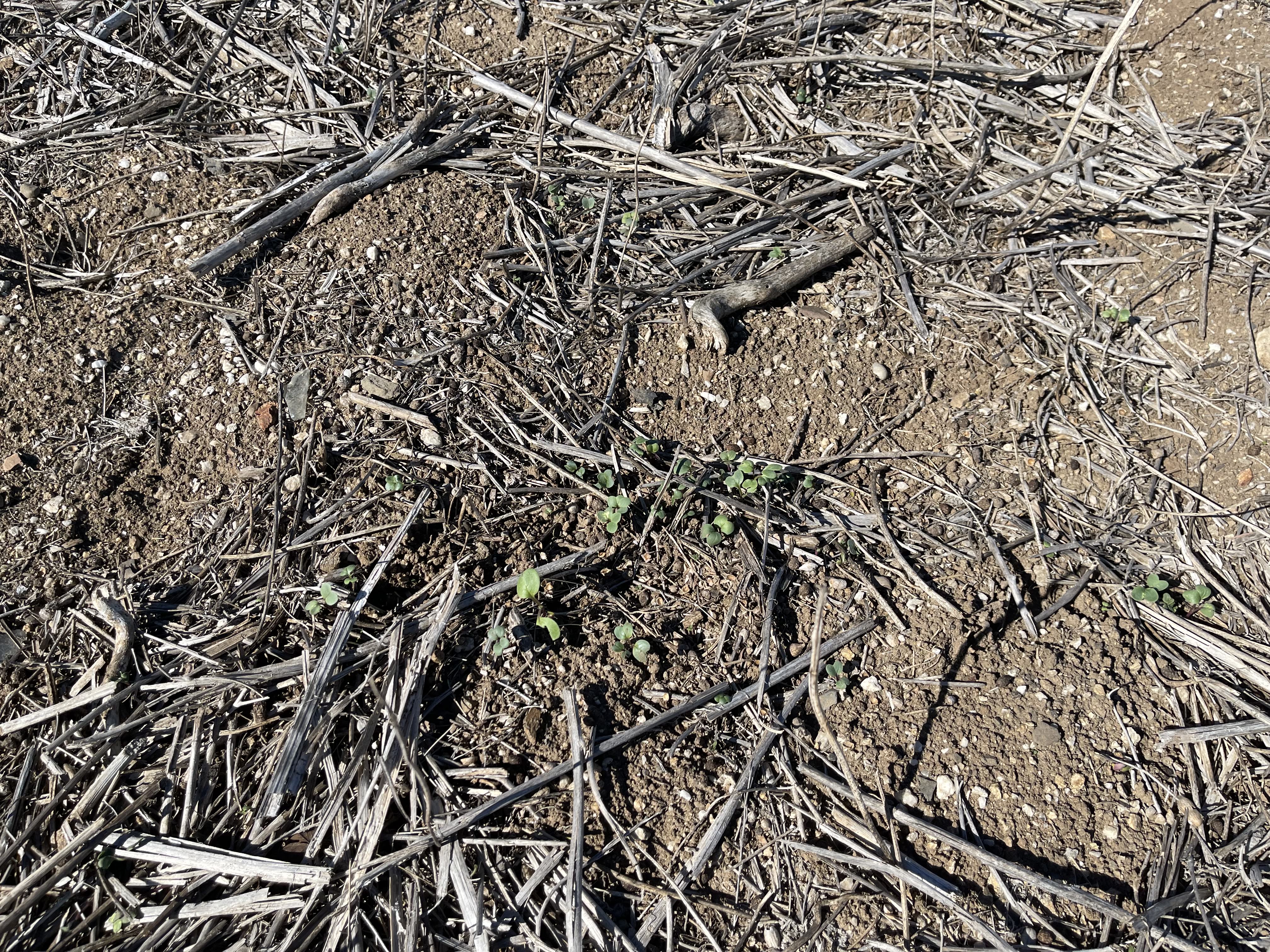

- diagram by Lara Lebeiko
*A note on black mustard: black mustard is an extremely resilient non-native brought to California from Europe. The plant with the huge green leaves with yellow flowers that covers the Los Angeles hillsides in the Spring. It does extremely well in nitrogen areas thriving off the nitrogen from our car exhaust pipes. It grows faster than our native species, choking them out before they’ve had a chance to grow. By removing it and planting natives, we are creating more much needed habitat that local species need to survive. It was also a huge fire hazard!
4. The Test
Climate experts predict a future of more extreme weather events. As we’ve seen this year, this can mean heavier rainfall, storms, and/or longer drought. As a studio class we developed a test based on these predictions using the selected species and planting strategy as variables for the site.
 We landed on a strategy that takes 3 different California native plant communities and intermixed them on site.
We landed on a strategy that takes 3 different California native plant communities and intermixed them on site. -Oak woodland based on the historic ecology of the north facing slope
-Coastal sagescrub based on the sites current ecosystem
-Grassland, a plant community that thrives in disturbance
The intent is that the diverse initial planting palette will allow the land to sort out into the appropriate future community makeup.


